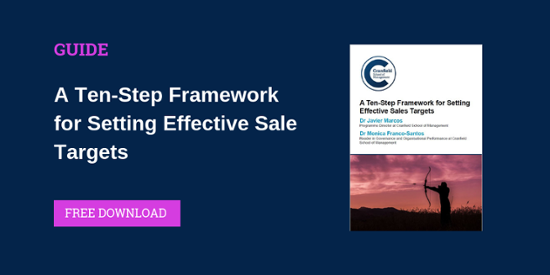Most organisations already have some elements of this framework, but it is rare to find a sales target system that features the entire framework in a holistic fashion. This framework comprises key practices that are required for ensuring that the performance measures used in the target setting process and the targets agreed are effective.
/SDP/Target-Setting%20Process%20Graphic%202018.jpg?width=399&name=Target-Setting%20Process%20Graphic%202018.jpg)
1. Review of stakeholder’s expectations
The first practice that should be undertaken when developing performance targets is a review of the organisation’s stakeholder expectations. Questions such as “who the organisation’s stakeholders are?” and “what they expect from this organisation?” are critical. This will help determine the areas that the organisation needs to address in order to be perceived as successful. Here the organisation’s level of market and customer-centricity will influence the areas of focus.
2. Selection and clarification of strategic objectives to be pursued
Articulate the stakeholders’ expectations into strategic objectives. Strategic objectives are clear statements of what the organisation aims to achieve. They must be few in number, and they should address those key stakeholders’ “needs” and “wants” (e.g. customers, employees, financial markets, etc.) This will help determine the types of measures the organisation may adopt.
3. Definition of the organisation’s success map
This is also known as ‘strategy map’ to show the cause-and-effect relationships among the different strategic objectives. Strategy maps facilitate visualising the connections across functions that result in value creation for stakeholders.
4. Prioritisation of objectives
Some strategic objectives will have more relevance than others at points in time. Therefore, it is crucial that the organisation clarifies its objectives and priorities.
5. Identification of measures
Strategic objectives need to be operationalised. Defining how each strategic objective is going to be measured. The measures that provide information of strategic importance for decision-making and resource allocation are often referred to as key performance indicators (KPIs).
6. Collection of activity and performance data
Once strategic objectives have been translated into clear KPIs, organisations define the data collection methods for the different KPIs and the tools and technology platforms to handle and manage the data, as well as the frequency and the individuals responsible for collecting the data.
7. Data analysis
At least two important aspects of data analysis must be conducted for each KPI:
- Forecasting – Careful consideration must be given to the methods used and to the intervening factors selected. As a rule of thumb, the more uncertainty there is in a specific market, the more factors will be required in the forecasting (e.g. competitors’ data, economic environment, internal capabilities). In uncertain contexts, historical information may not be an accurate predictor of future performance.
- Capability analysis—After data has been collected for a particular KPI, a rigorous analysis of this data must be conducted. The objectives of this analysis are (1) to understand how capable the organisation is of delivering the forecast figures, and (2) to identify the actions that must be taken in order to enable the organisation to deliver the forecast figures. A helpful tool at this stage is the use of control chart analysis. Control charts, are tools used in statistical process control to determine if a process is in a state of statistical control.
8. Setting targets
Once a forecast has been conducted and a proper capability analysis has been developed, then specific targets for the organisation’s sales KPIs can be defined.
9. Action plan design
After performance targets have been agreed, organisations need to spend the time deciding on the actions and initiatives that will help achieve the targets set.
10. Action plan discussion and agreement
Each target must be discussed and communicated together with the action plan designed to reach it. The action plan must be agreed with the team or individual who is going to be accountable for reaching the target. Action plans should not be ‘given’, they should always be discussed and agreed upon.
Having an emphasis on appropriate targets can create a fruitful context for high performance and fulfilment in sales. Thus, the best practice for sales leaders is to ‘use’ not ‘abuse’ targets in their sales organisations. Not just their sales forces, but also their customers will most likely ‘reward’ the organisation with their effort and loyalty respectively.
Dr Monica Franco-Santos, Reader in Governance and Organisational Performance, faculty on Sales Directors’ Programme, Cranfield School of Management.
Dr Javier Marcos, Programme Director of the Sales Directors’ Programme, Cranfield School of Management.
Check out more from the Cranfield School of Management, here.
— — — — — —
Posted here with permission from our 2019 National Sales Conference Sponsors, Cranfield School of Management.





